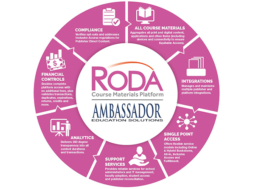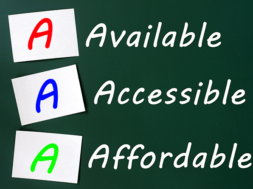
Why Inclusive Access Makes Sense Now More Than Ever
5 Ways to Maximize Inclusive Access for Students, Schools and Publishers
By Michelle Leontis, Vice President of Product Management, Ambassador Education Solutions
In what feels like the blink of an eye, the education process has all but been turned upside down, causing schools to rethink the learning experience and come up with new ways to ease and increase student engagement from a distance. An important piece of this puzzle is the course materials lifecycle.
Even before life as we knew it took an about-face, students’ primary course materials concerns focused on affordability and accessibility. Increasing costs weighed heavily on their minds, causing many to shop around for the best prices, oftentimes looking to the online marketplace. Yet students were not realizing the risks involved. Oftentimes course material prices on the open market change based on a seller’s quantities on hand. Supply might not be that high to begin with as these sites don’t tailor inventory to the number of enrolled students, not to mention, as inventory decreases prices can increase. Students also run the risk of paying multiple shipping charges if they can’t obtain all of their materials through the same marketplace provider. So much for the seemingly lower prices.
Additionally, students have long sought ease – ease in the way they purchase materials and ease in the way they use them.
Yet students have been forced to navigate multiple platforms depending on their required course materials. It’s time-intensive and confusing, to say the least, and more importantly, it can take away from the primary objective of learning.
Fast forward to where we are today. Affordability and accessibility are still students’ top course materials priorities, and maybe even more so in this increasingly remote learning environment and uncertain economic time. Students are counting on us. It’s never been more important for schools, publishers and course materials providers to come together to ease costs and complexities. Many schools are turning to an Inclusive Access model to address accessibility and affordability head-on, not just for the time being, but also as a means to improve sustainability and scalability for the long haul.
Why does Inclusive Access work?
Inclusive Access, by its very nature, is built around affordability and accessibility. Because more students are purchasing more materials, costs are spread over a larger student population. Students understand exactly what they are paying as the fee is either bundled with tuition or billed as a separate materials fee. Additionally, there is very little students need to do as they automatically receive their materials simply by enrolling in a course.
Shopping around for better prices usually goes by the wayside as pricing under an Inclusive Access model is competitive.
Plus federal requirements mandate that students have the option to opt-out, giving them the opportunity to choose to purchase course materials from an alternate source. Though most students don’t opt-out because of the low-cost high-convenience factors, students still must be given that choice.
When students are more prepared for class with their materials in hand, it increases the likelihood that they will be successful. Schools that deploy Inclusive Access programs have seen an increase in the number of students purchasing and using course materials, which can translate to stronger performance and learning outcomes. Plus, while Inclusive Access has the power to ease affordability and access now, it’s also a strategy that can transform course materials programs long-term.
5 must-haves to maximize Inclusive Access for students, schools and publishers
Inclusive Access programs, when implemented the right way, can simplify the entire course materials lifecycle for students, schools and publishers. The most successful Inclusive Access programs often revolve around these core principles:
1. Clear and compliant opt-out functionality – the opt-out process is a critical component of Inclusive Access. For starters, schools must have a clearly defined opt-out process in place so that they can meet and demonstrate compliance with the U.S. Department of Education requirements. To comply, students must be given a choice to opt-out as well as a simple path to complete the process. Students also need to understand when they are not permitted to opt-out (i.e., some custom materials or materials that could be considered to pose a health or safety risk), and they need the power to reverse their opt-out status so they can opt back in to receive materials as necessary and as their needs evolve.
2. Publisher direct content management – expanding on the importance of opting-out, the process for students to decline digital content such as eBooks, access codes and courseware is straightforward, but the opt-out process is far more challenging when it comes to LMS embedded Publisher Direct Content. This is because, among other things, varying access durations and duplicate usage complicate matters. Schools need the management processes in place to make sure the opt-out process works as it is intended for all print and digital content, regardless of the format. Additionally, because the links to Publisher Direct Content within the LMS tend to be openly available to enrolled students whether they opt-out or not, publishers need to be able to block access when appropriate. Locking down Publisher Direct Content for students who opt-out is critical to securing content.
3. Single point integrations – providing centralized access to all resources through a school’s Course Materials Platform is key to further simplifying the Inclusive Access process for everyone. For students, it facilitates single sign-on access and eliminates the need to jump around from platform to platform, giving them more time to focus on coursework and learning outcomes. For schools, more course materials options can mean more to manage and integrating with each and every publisher and digital platform is overwhelming. Schools need support to aggregate all content and manage all integrations through a centralized Course Materials Platform, which not only takes a tremendous burden off of a school’s IT resources and infrastructure, but it also means data is easier to access and manage. Publishers benefit too, as a single point for all integrations eases account management and reconciliation.
4. Analytics and financial controls – schools and publishers need transparency around usage and costs in an Inclusive Access program, but reporting can be difficult and time intensive. It’s important to have controls in place to align data with all content, including non-expiring, semester-based, or census-based content, as well as duplicate access for students who might use content in more than one course or over more than one term. Analytics and financial controls take away the guesswork, allowing schools and publishers to verify exactly who used what, who opted-out, and what is owed so that schools don’t overpay and publishers receive accurate compensation.
5. Dedicated support – even though Inclusive Access acquisition is automatic, students still need a point of contact for transaction inquiries, login questions and more. Students likely are feeling the distance right now, even if they are accustomed to learning remotely, and a direct connection with accurate and thorough support is important so they can keep focused on their studies.
There is no clear end in sight, and even as things evolve and we resume to what will be our new normal, the pandemic will leave a lasting impact. As schools prioritize the safety and well being of their students and staff in the immediate future, they also need to consider the simplest and best ways to keep everyone connected and progressing.
Now more than ever, students need peace-of-mind. They need to be reassured that their course materials are affordable and accessible, that they can focus their time and attention on learning, and that their institution is doing all it can do to support them.
Inclusive Access is not about a free quick fix, rather it’s about finding a solution that eases workflows for students, schools and publishers now, as well as scales with them long-term. Inclusive Access improves accessibility and affordability for students, not to mention streamlines operations for schools and publishers. Some might call it a win-win-win.
About Ambassador
Schools around the country trust their course materials and content integration programs to Ambassador Education Solutions. The company has been perfecting its Inclusive Access solution over the last 20 years, and has released enhanced functionality just ahead of the launch of its revolutionary new Course Materials Platform coming soon. For more information, visit www.ambassadored.com.
MICHELLE LEONTIS has more than 20 years of project and program management experience leading enterprise-wide efforts to launch new processes, products and solutions. As Vice President of Product Management at Ambassador Education Solutions, she acts as a trusted voice of the client, focusing on new product initiatives and integrations with an eye toward high quality student and client experiences that are customizable, configurable and scalable.
Contact Information: Michelle Leontis // Vice President, Product Management // Ambassador Education Solutions // 631-770-1010 // mleontis@ambassadored.com // www.ambassadored.com // @ambassador_ed










